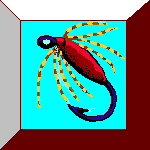



The mayfly spends most of its life as a nymph. This aquatic stage may last from 2 weeks to 2 years, depending on species and water temperature. Although most feed on algae and decaying organic matter, some are carnivorous. Because of the brevity of the adult stage, most scientific studies focus on the nymphal stages. In fact, the adult forms of many species have never been characterized.
The head of the nymph is variable in shape and may possess projections and armature in addition to moderately large eyes, mouthparts, and antennae.
Each of the three thoracic segments (prothorax, mesothorax, and metathorax) bears a pair of legs and developing wingpads can be found on the mesothorax and (in most species) metathorax. In some species the legs are modified for filtering food, grooming, or burrowing.
All mayflies have 10 abdominal segments each of which may bear gills, depending on the species. In most species, abdominal segment 10 bears 3 caudal filaments: the central terminal filament and two cerci. In some species the terminal filament is reduced or absent.

Unlike any other insect, mayflies have two winged stages: the dun (subimago) and spinner (imago). Upon emerging from the final nymphal shuck, the (usually) sexually immature dun can be easily recognized because the entire insect is covered by a dense layer of microscopic hair (microtrichia) which causes the insect to be waterproof and probably prevents it from being trapped in the surface film. These microtrichia also cause the dun to have much less luster than the spinner. In many species the dun emerges at dusk and transforms into the spinner before dawn. After shedding the subimago exoskeleton, the spinner, which lacks microtrichia, appears glossy and its wings are often transparent (hyaline).

The head of the adult male and female are different: the eyes of the male being larger. The mouthparts are reduced and non-functional.
As in the nymph, each thoracic segment in the adult bears a pair of legs. The forelegs of the male are usually much longer than the middle- or hind legs. In a few species the legs are much reduced. The mesothorax bears a pair of forewings and the metathorax usually bears a pair of smaller hind wings which are much reduced or absent in some species.

The major wing veins are known as costa (C), subcosta (Sc), radius (R), medius anterior (MA), medius posterior (MP), cubitus anterior (CuA), cubitus posterior (CuP), and anal (A). Intercalary veins (IMA, IMP) lie between the major veins. The presence or absence of free marginal veinlets can be used to key some species.

The angle of the costal projection on the hind wing can be a useful characteristic when keying some species.

Each of the abdominal segments is composed of a dorsal tergum and a ventral sternum. Genitalia are borne on the posterior portion of sternum 9 which is known as the subanal plate in the female and the subgenital plate in the male.

The subgenital plate bears a pair of forceps (or claspers) and a pair of penes.

The legs of the nymphs of such genera as Ephemeridae and Potamanthidae are flanged to facilitate digging in the mud or sand at the bottom of lakes or rivers. (Dorsal view)

The tarsal claw on the foreleg of Siphloplecton is double.

The form and location of the gills varies greatly and are a useful characteristic when keying mayflies. For example, the absence of gills on abdominal segments 1 and 2 (and sometimes 3) is diagnostic of the Ephemerellidae.
Similarly, the shape of the large, operculate gills of Caenidae can be used to differentiate between Tricorythodes, Brachycercus, and Caenis. (Ventral view.)

Whether the shape of the gills are uniform or not can also be used to characterize mayflies. For example, in Leptophlebia the gills attached to abdominal segment 1 are deeply forked while those on segments 2-7 are flat, platelike and bear a long apical extension.

The gills of Rithrogena are enlarged and overlapping; forming an adhesive disk the nymph uses to cling to rocks in rapidly-flowing water. (Ventral view.)

Nymphs of Isonychia exhibit gill tufts on their maxillae and the bases of their forelegs. (Ventral view.)

The detailed morphology of the parts of the head can also be used to key mayflies. For example, the number of segments in the labial- and maxillary palps, length of antennae, and the relative sizes of ocelli can be used to differentiate species. (Front view.)

The distinctive carapace-like extension of the mesonotum is characteristic of Baetisca spp.

The presence of tusks and their shapes are characteristic of some species. (Side view of head of Ephemera nymph.)

The relative sizes of the legs, their functionality, and the number and relative sizes of the segments can help key mayfly adults.

The exact pattern of veins in the wings are unique to each species. For example, the shape of a specific vein (designated MP2) is characteristic of Ephemera.

The presence of specific intercalary veins help identify the following mayflies: The fore wings of Ephemerellidae exhibit one or two long, intercalary veins between the second medius posterior vein (MP2) and the cubitus anterior vein (CuA).

The forewings of Metretopus exhibit a single pair of cubital intercalary veins.

The forewings of Siphloplecton exhibit two pairs of cubital intercalary veins.

The presence or absence of cubital intercalary veins and free marginal veinlets differentiates Ametropidae from Baetidae.

The reproductive organs, especially the size and shape of the forceps and penes are important taxonomical traits.




